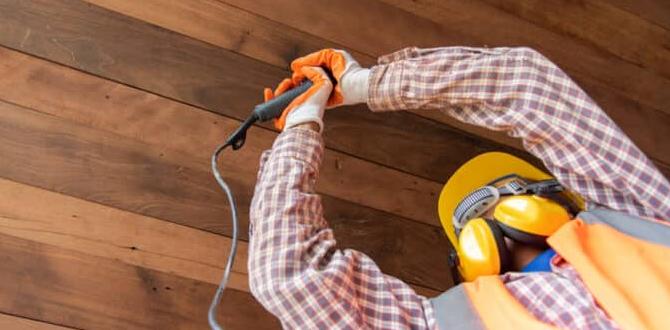Quick Summary:
Properly cleaning and storing your nail gun is crucial for its longevity and your safety. This guide provides straightforward steps for both pneumatic and electric nail guns, ensuring they remain in top condition and ready for your next project. Learn simple, effective methods to keep your tools working perfectly.
Hey there, DIYer! Jack Shaffer here, your go-to guy for all things nail guns. Ever finished a project with your trusty nailer, only to wonder what to do with it next? Stashing it away without a second thought might seem easy, but it can lead to all sorts of problems down the line. Dust and debris can gum up the works, leading to misfires or jams. Worse still, improper storage can make your nail gun unsafe for its next use. Don’t worry, though! I’ve got your back with some easy-to-follow tips that will keep your nail gun running smoothly and safely for years to come. Let’s dive in and make sure your tools are always project-ready!
Table of Contents
Why Cleaning and Storing Your Nail Gun Matters
Keeping your nail gun clean and stored correctly isn’t just about making it look good; it’s essential for performance and, most importantly, your safety. Think of your nail gun like any other precision tool – it needs a little TLC to operate at its best.
Performance Boost
A clean nail gun fires nails more consistently. When dust, wood chips, or old lubricant build up inside, it can obstruct the firing mechanism. This can lead to:
- Nail jams: The nail might not seat properly or get stuck before being fired.
- Inconsistent depth: Nails might be driven too deep or not deep enough.
- Misfires: The gun might not fire at all, even when triggered.
Safety First
Your safety is paramount. A dirty or improperly stored nail gun can be a hazard. For example, if the safety contact tip is clogged, it might not engage properly, increasing the risk of accidental firing. Also, if you’re using a pneumatic nailer, residual air pressure left in the system due to poor storage habits can be dangerous.
Extended Tool Lifespan
Regular maintenance, including cleaning, is like giving your nail gun a healthy shield against wear and tear. It helps prevent rust, corrosion, and premature breakdown of internal components. This means your tool will last longer, saving you money in the long run.
Ready for Action
When your nail gun is clean and properly stored, you can grab it and get to work without any hiccups. No frustrating jam sessions or performance issues to slow you down – just seamless operation for your next DIY adventure.
Essential Tools and Supplies for Cleaning
Before you start cleaning, gather the right tools. Having everything on hand makes the process much smoother and more effective. Don’t worry; these are mostly common items you might already have around your workshop.
For Pneumatic Nail Guns:
Pneumatic nail guns rely on compressed air, so their cleaning might involve slightly different steps than electric models.
- Safety Glasses: Always protect your eyes!
- Gloves: To keep your hands clean and protect them from any sharp edges.
- Compressed Air Can or Blower: For blowing out dust and debris.
- Lint-Free Cloths: For wiping down surfaces.
- Small Brush (e.g., toothbrush, parts brush): For scrubbing away stubborn gunk.
- Nail Gun Lubricant (specific for air tools): Crucial for pneumatic nailers.
- Thread Seal Tape (Teflon tape): For air hose connections.
- Screwdriver (if needed to access certain parts): Check your manual.
For Electric and Cordless Nail Guns:
Electric and cordless models have motors and battery components that require gentle cleaning.
- Safety Glasses: Your first line of defense.
- Gloves: Keep your hands clean and protected.
- Lint-Free Cloths: For wiping surfaces.
- Small Brush (e.g., toothbrush): For reaching small crevices.
- Mild Cleaning Solution (e.g., a little dish soap and water, or an electronics cleaner for battery contacts): Use sparingly and only on appropriate parts.
- Cotton Swabs: Great for tight spots and battery contacts.
- Screwdriver (if needed): Refer to your user manual.
How to Clean Your Nail Gun: Step-by-Step Guide
Cleaning your nail gun doesn’t have to be a daunting task. I’ll break it down into simple steps for both pneumatic and electric/cordless models. Remember, always refer to your specific tool’s manual for detailed instructions, as designs can vary.
Step 1: SAFETY FIRST – Disconnect Power/Air
This is the MOST IMPORTANT step. Never attempt to clean your nail gun while it’s connected to an air compressor or has a battery attached, and always remove any nails from the magazine. Trust me on this one; an accidental firing during cleaning can cause serious injury.
- Pneumatic Nail Guns: Completely disconnect the air hose from the nail gun. Ensure there’s no residual air pressure in the line or the tool.
- Electric/Cordless Nail Guns: Remove the battery pack. If it’s a corded electric model, unplug it from the power source.
- All Nail Guns: Visually inspect the magazine and clear out any remaining nails.
Step 2: Exterior Cleaning
Start by giving the outside of your nail gun a good wipe-down. This removes surface dust and grime.
- Use a clean, lint-free cloth to wipe down the entire exterior of the tool. Start with a dry cloth.
- For tougher grime, slightly dampen a cloth with water or a very mild cleaning solution (like a tiny bit of dish soap in water). Be careful not to get water into any openings like the air inlet or exhaust port.
- Wipe down the handle, body, and any plastic or metal parts.
- Pay attention to the trigger area and the housing.
Step 3: Cleaning the Magazine and Feed Path
The magazine is where the nails are held, and it’s critical for smooth feeding. Debris here is a common cause of jams.
- Open the magazine latch or slide.
- Use compressed air to blow out any dust, wood shavings, or old nail fragments from inside the magazine.
- If there’s stubborn gunk, use a small brush (like a toothbrush) to dislodge it, then blow it out with compressed air.
- Wipe the inside of the magazine with a lint-free cloth.
- For the feed path (where the nail slides to the tip), gently use a brush and compressed air to clear it. Avoid using lubricants here unless your manual specifically instructs you to.
Step 4: Cleaning the Safety Contact Tip (Nose)
The safety contact tip (also called the nose or contact-trip mechanism) is what you press against the material before pulling the trigger. Keeping this clean and free of obstruction is vital for proper function and safety.
- Inspect the safety contact tip for any debris.
- Use a brush and/or compressed air to clean around and under the tip. Make sure it can move freely in and out.
- Some advanced users might occasionally remove the safety tip assembly for a more thorough clean, but this is often unnecessary for basic maintenance and can be tricky. If you’re unsure, stick to cleaning around it. Always consult your manual if you consider disassembling any part.
Step 5: Lubrication (Primarily for Pneumatic Nailers)
Pneumatic nail guns require lubrication to keep their internal pneumatic components moving smoothly. Electric models usually have sealed motors and don’t require this step on user-serviceable parts.
- Pneumatic Nail Guns:
- Locate the air inlet port.
- Apply 2-3 drops of specialized nail gun lubricant (often called air tool oil). Do NOT use WD-40 or other general lubricants; they can gum up seals.
- Reconnect the air hose.
- Briefly fire the nail gun (safely, into scrap material or with the nose depressed) a few times to distribute the lubricant. You might see a puff of oil vapor from the exhaust port – this is normal.
- Disconnect the air hose again.
Step 6: Check and Clean Air Fittings (Pneumatic)
For pneumatic nailers, ensure the air inlet and any quick-disconnect fittings are clean and secure.
- Wipe down the air inlet nipple.
- Check the threads for any damage.
- If you’re disconnecting and reconnecting hoses frequently, applying a fresh layer of thread seal tape (Teflon tape) to the male threads of your air hose connector can help prevent air leaks.
Step 7: Battery Terminals (Electric/Cordless)
For cordless nailers, clean battery contacts to ensure a good connection.
- Remove the battery.
- Use a dry cloth or a cotton swab (perhaps very lightly dampened with isopropyl alcohol, if corrosion is visible) to clean the metal contacts on both the battery and the tool.
- Ensure they are completely dry before reinserting the battery.
Step 8: Final Wipe Down and Inspection
Give your nail gun one last clean sweep. Check for any loose parts or visible damage.
- Perform a final wipe-down with a dry, lint-free cloth.
- Ensure all parts are secure.
- Do a visual check for any cracks, loose screws, or damaged components. If you find anything concerning, consult your user manual or contact the manufacturer.
Proper Storage Methods for Longevity and Safety
Once your nail gun is clean, storing it correctly is key to maintaining its condition and ensuring it’s safe for your next project. Proper storage protects it from damage, moisture, and accidental activation.
The Importance of the Original Case
If you still have the original carrying case that came with your nail gun, use it! These cases are designed to:
- Protect from Dust and Debris: Keeps your freshly cleaned tool pristine.
- Prevent Impact Damage: Cushions the tool against bumps and drops.
- Keep Parts Together: Sometimes cases have compartments for accessories like hex wrenches or extra magazines.
- Secure Storage: Helps prevent accidental trigger pulls if designed well.
Ideal Storage Locations
Where you store matters. Think about the environment your tool will be in:
- Dry Environment: Moisture is the enemy of metal tools, leading to rust. Avoid damp basements or garages prone to high humidity.
- Stable Temperature: Extreme heat or cold can affect lubricants and plastic components. A climate-controlled workshop or an indoor closet is ideal.
- Away from Direct Sunlight: Prolonged exposure can degrade plastic parts and adhesives.
- Secure Location: Store your nail gun where it won’t be accidentally knocked over or where children cannot access it.
Specific Storage Tips by Nail Gun Type
While general rules apply, a few specifics are worth noting:
Pneumatic Nail Guns
Because these rely on air pressure, specific considerations are important:
- Ensure Air is Depressurized: After cleaning and lubricating, make sure no air is left in the tool or hose. Disconnecting the hose is usually enough, but if you have a regulator, ensure it’s set to zero.
- Store Hose Separately or Neatly Coiled: A coiled air hose can also become a tripping hazard if not managed.
- Keep Away from Liquids: Even the air supply can sometimes carry moisture. Ensure your compressor’s water traps are functioning.
Electric and Cordless Nail Guns
Battery care and electrical components are key here:
- Battery Storage: If storing for extended periods (more than a month), check your manual. Many manufacturers recommend storing batteries partially charged (around 40-60%). Storing them fully charged or completely depleted can degrade battery life over time. Store batteries in a cool, dry place, ideally in their own protective case if provided. Learn more about lithium-ion battery best practices from Energy Star.
- Cord Management (Corded Models): Wrap the power cord neatly to avoid kinks or damage. Avoid wrapping it too tightly around the tool, which can stress the cord connection.
- Protect the Trigger: Ensure the trigger mechanism is not exposed to excessive force or debris that could cause it to stick.
Long-Term Storage
If you won’t be using your nail gun for several months:
- Clean Thoroughly: A deep clean is especially important before long-term storage.
- Lubricate (Pneumatic): Ensure it’s properly lubricated.
- Remove Battery (Cordless): Store the battery separately, as mentioned above, at a partial charge.
- Consider a Light Oiling (for metal parts, if manual permits): Some people like to apply a very light film of oil to exposed metal parts of pneumatic tools if storing in a less-than-ideal environment, but check your manual first, as modern tools often have protective coatings and lubricants that shouldn’t be disturbed unnecessarily.
- Store in the Case: This offers the best protection.
Troubleshooting Common Nail Gun Issues Related to Cleaning/Storage
Even with the best care, you might encounter issues. Many common problems can be traced back to cleaning or storage neglect.
Issue: Nail Gun Not Firing
Possible Cause: The safety contact tip or magazine feed path is clogged with debris. The safety lock-out mechanism might be stuck.
Solution: Perform a thorough cleaning of the nose and magazine as described in this guide. Ensure the safety contact tip moves freely. Check that the magazine latch is fully engaged. For cordless tools, ensure the battery is fully charged and properly seated; a low battery can sometimes appear as a “no fire” issue.
Issue: Nails Jamming Frequently
Possible Cause: Debris in the magazine or feed chute. Insufficient lubrication in pneumatic models. Damaged magazine lips.
Solution: Clean the magazine and feed path meticulously. For pneumatic tools, ensure you’re using the correct air tool oil and applying it regularly. Inspect the magazine for any bends or damage and replace if necessary. Ensure you’re using the correct nail collation (angle, size, type) for your tool.
Issue: Inconsistent Nail Depth
Possible Cause: Air leaks (pneumatic), clogged air exhaust, or the safety contact tip isn’t depressing fully due to dirt. Low air pressure.
Solution: Check for air leaks around fittings and the air inlet. Clean the safety contact tip. Ensure your air compressor is set to the recommended pressure for your nail gun (refer to your tool’s manual – this is crucial for consistent performance). For electric models, ensure the depth adjustment setting (if present) is correctly configured.
Issue: Nail Gun Leaks Air (Pneumatic)
Possible Cause: Loose air hose connection, worn O-rings or seals, or damaged air fittings.
Solution: Ensure the air hose is securely connected. Check the thread seal tape on your hose fittings. If leaks persist from the tool itself (especially around the air inlet or exhaust), it might indicate internal wear or a damaged seal. This usually requires professional service or replacement. Regular lubrication helps maintain these seals.
Table: Pneumatic vs. Electric/Cordless Nail Gun Cleaning Differences
Here’s a quick comparison to highlight the key distinctions in maintenance.
| Feature | Pneumatic Nail Gun | Electric/Cordless Nail Gun |
|---|---|---|
| Power Source | Compressed Air | Electricity (corded or battery) |
| Primary Cleaning Fluid | Compressed Air, Mild Cleaner (exterior only), Air Tool Oil (internal) | Lint-free Cloth, Mild Cleaner (exterior), Isopropyl Alcohol (battery contacts) |
| Lubrication Need | Yes, periodic application of air tool oil is essential for internal moving parts. | No user-added lubrication for internal motor/mechanism; rely on factory sealed components. Battery contacts may need cleaning. |
| Air Pressure Consideration | Crucial for operation; ensure tool is depressurized before cleaning. Check pressure settings regularly. | Not applicable. |


